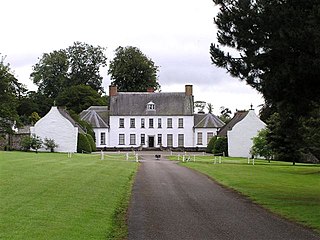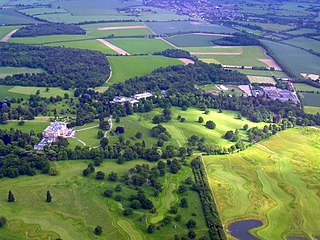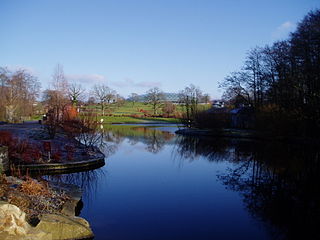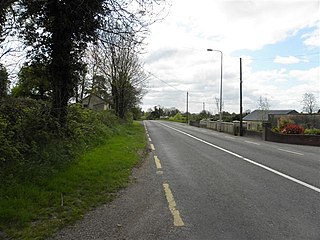Related Research Articles

Springhill is a 17th-century plantation house in the townland of Ballindrum near Moneymore, County Londonderry in Northern Ireland. It has been the property of the National Trust since 1957 and, in addition to the house, gardens and park, there is a costume collection and a purported ghost. It is open from March to June, and September on weekends, and is open to the public seven days a week during July and August.

Luton Hoo is an English country house and estate near Luton in Bedfordshire and Harpenden in Hertfordshire. Most of the estate lies within the civil parish of Hyde, Bedfordshire. The Saxon word Hoo means the spur of a hill, and is more commonly associated with East Anglia.

Samuel Pepys Cockerell (1753–1827) was an English architect.

The National Botanic Garden of Wales is a Botanical Garden located in Llanarthney in the River Tywi valley, Carmarthenshire, Wales. The garden is both a visitor attraction and a centre for botanical research and conservation, and features the world's largest single-span glasshouse, measuring 110 m (360 ft) long by 60 m (200 ft) wide.
Armar Lowry-Corry, 1st Earl Belmore was an Irish nobleman and politician.

Sezincote House is the centre of a country estate in the civil parish of Sezincote, in the county of Gloucestershire, England. The house was designed by Samuel Pepys Cockerell, built in 1805, and is a notable example of Neo-Mughal architecture, a 19th-century reinterpretation of 16th and 17th-century architecture from the Mughal Empire. At the time of its construction, British India was becoming the "jewel in the crown" of the world's largest empire. According to Shashi Tharoor, the palace is an 'incongruous monument to the opulence of the nabobs' loot', referring to the construction of the palace using the wealth acquired by the East India Company's loot and plunder in Bengal.

Hugh Cholmondeley, 2nd Baron Delamere, styled The Honourable from 1821 until 1855, was a British peer and politician.

Wroxall Abbey is a substantial Victorian mansion house situated at Wroxall, Warwickshire which was converted for use as a hotel, spa, wedding venue and conference centre. It is a Grade II listed building.
Hugh de Fellenberg Montgomery (1844–1924) was an Ulster Unionist Party member of the Senate of Northern Ireland from 1922 until his death in 1924.
Frederick Pepys Cockerell was a British architect. He was the second son of Charles Robert Cockerell, also an architect, whose favour for French architecture and sculpture in architecture was a major influence on Frederick.

Pyrton is a small village and large civil parish in Oxfordshire about 1 mile (1.6 km) north of the small town of Watlington and 5 miles (8 km) south of Thame. The 2011 Census recorded the parish's population as 227. The toponym is from the Old English meaning "pear-tree farm".

Rose Hill Manor, now known as Rose Hill Manor Park & Children's Museum, is a historic home located at Frederick, Frederick County, Maryland. It is a 2+1⁄2-story brick house. A notable feature is the large two-story pedimented portico supported by fluted Doric columns on the first floor and Ionic columns on the balustraded second floor. It was the retirement home of Thomas Johnson (1732–1819), the first elected governor of the State of Maryland and Associate Justice of the United States Supreme Court. It was built in the mid-1790s by his daughter and son-in-law.

Hampton Gay is a village in the Cherwell Valley about 1.5 miles (2.4 km) north of Kidlington, Oxfordshire.
The High Sheriff of Fermanagh is the Sovereign's judicial representative in County Fermanagh. Initially an office for lifetime, assigned by the Sovereign, the High Sheriff became annually appointed from the Provisions of Oxford in 1258. Besides his judicial importance, he has ceremonial and administrative functions and executes High Court Writs.
The High Sheriff of Tyrone is the Sovereign's judicial representative in County Tyrone. Initially an office for lifetime, assigned by the Sovereign, the High Sheriff became annually appointed from the Provisions of Oxford in 1258. Besides his judicial importance, he has ceremonial and administrative functions and executes High Court Writs.

Cavanagh is a townland in the civil parish of Tomregan, County Cavan, Ireland. It lies within the former barony of Tullyhaw.
Rakeelan is a townland in the Parish of Tomregan, Barony of Tullyhaw, County Cavan, Ireland.

Daylesford House is a Georgian country house near Daylesford, Gloucestershire, on the north bank of the River Evenlode near the border with Oxfordshire. It is about 5 miles (8.0 km) east of Stow-on-the-Wold and 5 miles (8.0 km) west of Chipping Norton. The village of Daylesford lies nearby to the west, Adlestrop to the north, Cornwell to the east, and Kingham to the south,

Knuthenborg is a manor house located 6 km (3.7 mi) north of Maribo on the Danish island of Lolland. Originally known as Årsmarke, it was first mentioned in 1372. Today's building was completed in 1866 to a design by Henrik Steffens Sibbern. The medieval manor of Årsmarke, with its more than 300 years of history, was once Denmark's largest private estate; it is now part of Knuthenborg Safaripark. The exotic shrubs and trees planted during the era of the Counts of Knuthenborg are situated on the grounds.

Ashley Park is a private residential neighbourhood at Walton-on-Thames in Surrey. Its central feature was a grandiose English country house, at times enjoying associated medieval manorial rights, which stood on the site, with alterations, between 1605 and the early 1920s. Its owners included Charles Sackville, 2nd Duke of Dorset, in the 18th century and members of the Sassoon family around the turn of the 20th century.
References
- 1 2 3 "Blessingbourne House-Victorian Manor House" . Retrieved 17 August 2012.
- ↑ "Blessingbourne MTB Centre, Tyrone" . Retrieved 17 August 2012.
- ↑ "Blessingbourne House" . Retrieved 24 October 2013.